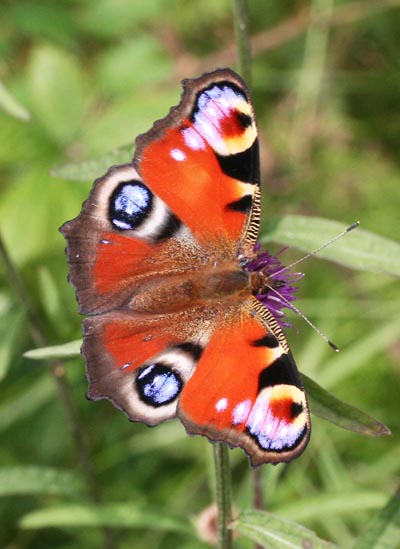My last post showed images from a woodland ride which is bounded on the northern side by a mature Spruce plantation, and on the southern side by Beech. Over the last couple of days I have been closely examining some more of the photographs, and I realised that I have a very illustrative set of images of one species of hoverfly that was causing me more than a little bit of bother to identify.
This is the first shot:
My initial reaction was "
Cheilosia illustrata, but a very bright specimen". So I rattled off a few more shots as it wandered over the flowerhead:
When I examined the photographs back at the computer, I quickly realised that my initial identification was wrong. Firstly, the face is yellow, and there are no grooves running down between the eyes and face:
Those features rule out Cheilosia.
So what is it?
A quick examination of the wing veins ruled out Eristalis sp., because the Eristalis 'bulge' is not present:
 |
| Archive image of the distinctive Eristalis 'bulge' |
Here is the actual wing:
The arrow shows another distinguishing feature of the wing, where the marginal vein curves back to make an obtuse angle with the central vein. This obtuse angle rules out Volucella species. Just to confirm, I checked the aristae, which are the small projections on the antennae. The ones on this specimen are simple and not feathered, so that again rules out Volucella species:
Let's look at the legs:
The legs are clearly not all black, so that rules out Merodon species.
I was struggling at this point, because I had ruled out all of the common bumblebee mimics, and the image didn't match any others in the standard reference book.
I decided to bite the bullet and key the specimen from scratch, which led me to tribe Syrphini, and only one member of that tribe remotely resembles a bumblebee, and that is
Eriozona syrphoides. A quick check of the species description for
Eriozona syrphoides reveals:
"At first sight, Eriozona is like an outsized
Cheilosia illustrata, but the face is yellow in Eriozona."
"Most records are for Spruce plantations or deciduous woodland where spruce is present."
"May to October, with a second peak in August".
Things are looking good for
Eriozona syrphoides. But it's a rare species, which I had only seen
once before, in another Spruce plantation some 30 km. away. I was still a little bothered that the illustrations didn't match, so I did a quick google search of images for
Eriozona syrphoides, and it was immediately obvious that there are two distinct colour forms: one that is in the book and matches my
first specimen and another, much brighter version, which is the version I found on Wednesday.
So there we have it:
 |
| The hoverfly Eriozona syrphoides (male) |
Time taken for the identification? Around two hours.
Eriozona syrphoides is a European species new to Ireland (the first sighting was in 1998) and follows on from sightings in England and Wales in the 1960's. It is closely associated with Spruce plantations (the larvae are predators of aphids that feed on conifers), so the species is clearly spreading as Spruce plantations mature. I'm usually very critical of the negative effect that Spruce plantations have on local biodiversity, but in this case I have to make an exception:
Eriozona syrphoides is a very handsome hoverfly.
(Late note: I wonder if the two colour forms are male and female, since my
previous specimen was a female). More checking.....
Later note: Once I had finalised this identification, I realised that a specimen shown previously from this same location was actually this species. I have amended the previous page accordingly.


















































